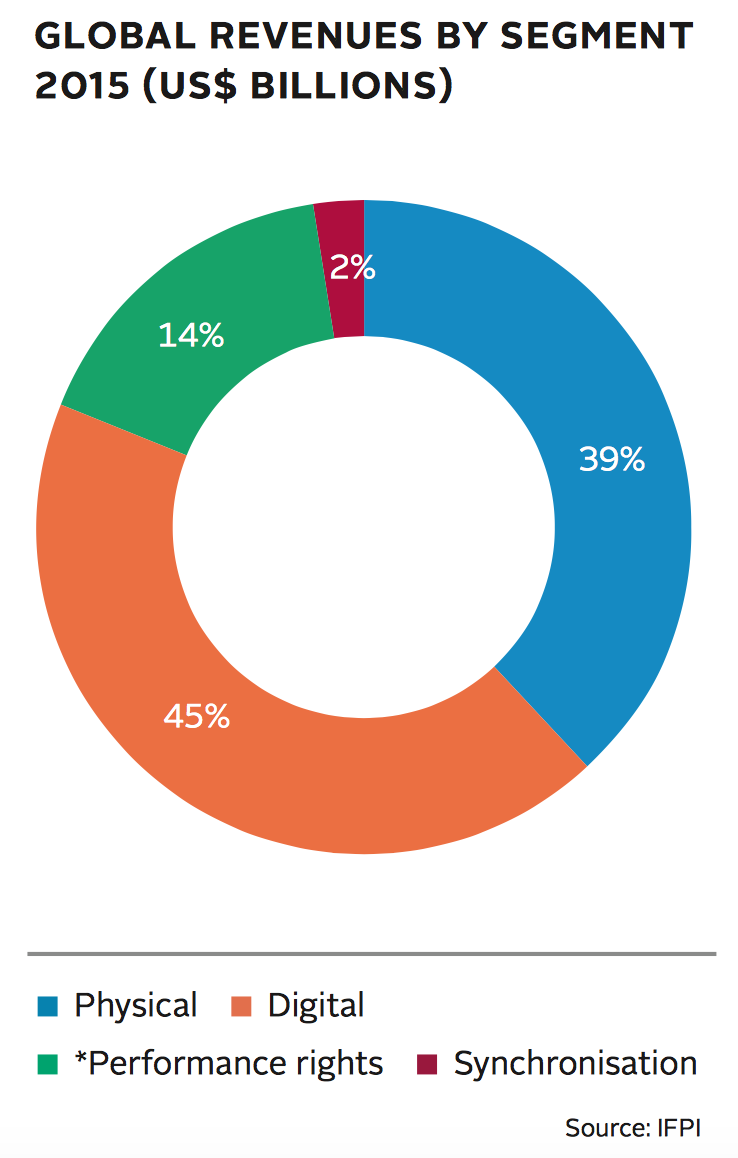 Today the IFPI released their annual report and for the first time ever digital revenue has surpassed physical revenue.
Today the IFPI released their annual report and for the first time ever digital revenue has surpassed physical revenue.
In 2015 the global music market reached a major milestone as digital consumption surpassed physical, making it the primary revenue stream for the recorded music industry. Of the total global music revenue in 2015 digital accounted for 45% overtaking physical’s 39% share.

The global digital revenue increased by 10.2% to $6.7 billion with a massive 45.2% increase in streaming revenue which offset the decline in physical revenue which fell 4.5% and download revenue which fell 10.5%.

The above graph highlights the decline in physical revenue over the past 10 years and the significant rise in digital revenue within the same time period.
In 2014 digital and physical revenue were on par with each other for the first time, and now digital revenue has outweighed physical for the first time ever. The shift from physical to digital consumption is due to a number of reasons; technological advances and the rise in mobile phone consumption have been the main drivers of this change.
Global music revenue rose 3.2% to $15.0 billion – The music industry’s first year-on-year growth in nearly two decades.
The global music revenue has seen growth as a result of the uprise of streaming services, like Spotify, Apple Music, Tidal and several others.
Streaming revenue’s 45.2% increase constitutes to a massive $2.9 billion in revenue for the music industry, and over the past five years streaming revenue has grown more than four-fold.

Of the total global music revenue, streaming makes up 19% which is a rise from 2014 where it took a 14% share. Streaming now accounts for 43% of digital revenue which is close to overtaking downloads 45% share.
It is evident that people are responding well to streaming platforms as premium subscriptions have also seen a dramatic increase in recent years with an estimated 68 million people now paying for a music subscription service.

Between 2012 and 2013 paid subscriptions increased by 8 million, between 2013 and 2014 it increased by 13 million, and between 2014 and 2015 it increased by 27 million.
This shows that paid subscriptions have been steadily increasing up until last year when they was a sharp spike in user numbers. This was a result of Spotify’s growth, and Apple Music fierce entrance into the music streaming market – racking up 10 million paid subscribers in 6 months in 2015. Also, Tidal entered the streaming market and by the end of 2015 had reached over a million users. Both Apple Music and Tidal have no free ad-supported version available.
Summary
The IFPI report highlighted some fundamental facts: the overall global music revenue increased for the first time in 20 years, digital revenue surpassed physical revenue, streaming revenue is expected to overtake digital revenue in the near future, there are more paid subscribers to streaming services than ever before and it is increasing significantly year-on-year.
However despite the explosion in music consumption, artists and record labels are not receiving a fair remuneration causing a ‘value gap’.
In the report IFPI Chief Executive, Frances Moore spoke out on the ‘value gap’.
”The value gap is the biggest constraint to revenue growth for artists, record labels and all music rights holders. Change is needed – and it is to policy makers that the music sector looks to effect change”.
IFPI says that the ‘value gap’ arises as a result of some major digital services like YouTube that are able to ”circumvent the normal rules that apply to music licensing”. The IFPI goes on to say that these services ”conclude licenses at artificially low rates claiming protection from so-called ‘safe harbour’ rules that were introduced in the early days of the internet”.
The post IFPI: Digital Revenue Overtakes Physical For The First Time Ever appeared first on Digital Music News.